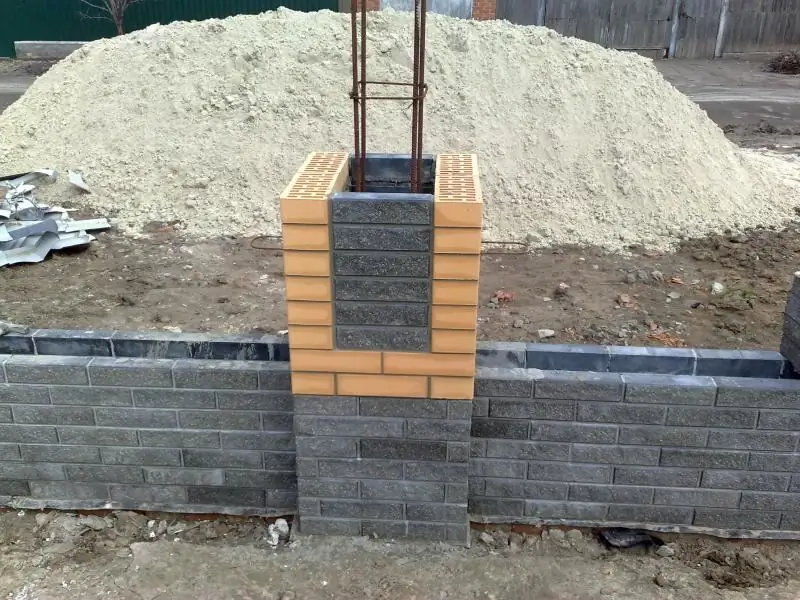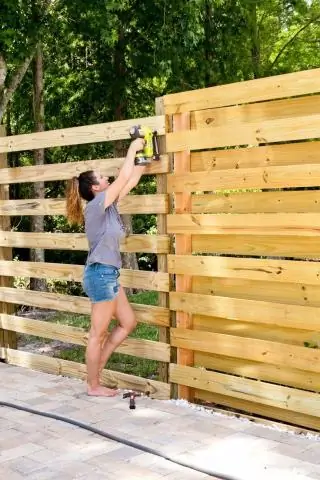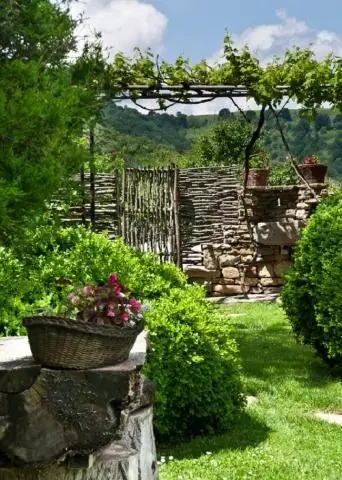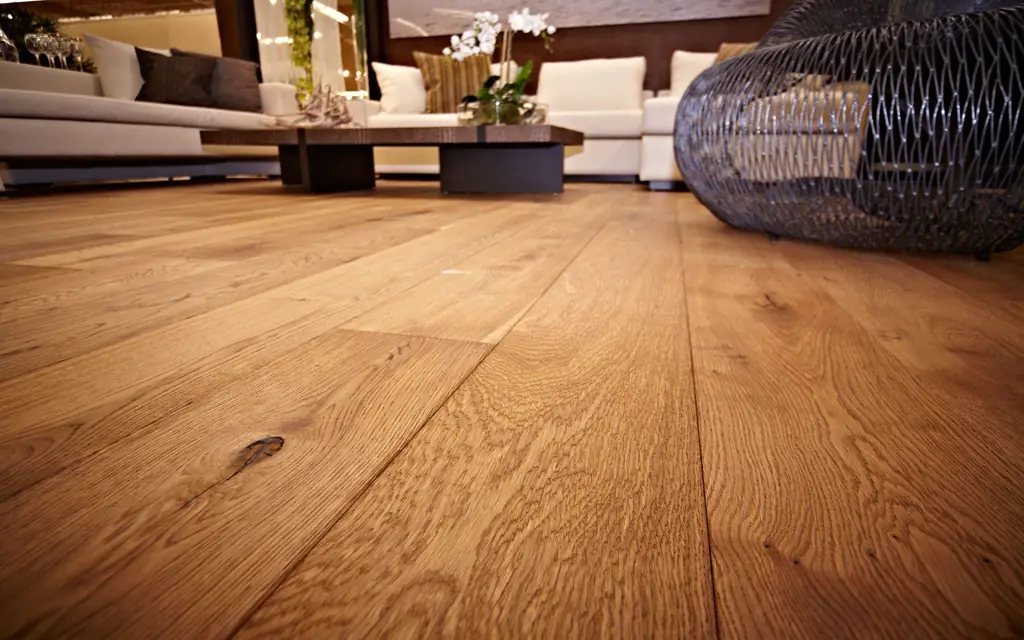
Table of contents:
- Author Bailey Albertson [email protected].
- Public 2023-12-17 12:53.
- Last modified 2025-06-01 07:32.
How to properly install the fence posts yourself

Building a fence for your home is just as important a building process as building the house itself. For a reliable fence structure that can withstand the weight of heavy materials, temperature changes in the soil and exposure to strong winds, an appropriate foundation is required. In the case of improper strengthening of the supporting structures of the fence, you may encounter such unpleasant moments as deformation or destruction of the building. To prevent this from happening, you need to determine how to correctly install the pillars.
Content
-
1 How to install fence posts: advantages and disadvantages of installation methods
- 1.1 Table: methods of mounting poles
- 1.2 How far are the posts installed?
-
2 We hammer the pillars
-
2.1 Preparatory work: the choice of material for the pillars, tips for choosing, calculating the amount
- 2.1.1 Tree
- 2.1.2 Metal
- 2.1.3 Concrete and asbestos-cement pipes
- 2.1.4 Brick
- 2.1.5 Calculation of materials
- 2.2 Required tools
- 2.3 Instructions for installing do-it-yourself fence posts by hammering into the ground
- 2.4 Is processing required and how?
-
-
3 Concrete pillars
- 3.1 Preparatory work, selection of materials and calculations (with examples)
- 3.2 Required tools
- 3.3 Step by step instructions
- 3.4 Video: how to hammer fence posts
- 3.5 Video: foundation for the fence
How to install fence posts: advantages and disadvantages of installation methods
Any installation of support posts for the fence implies their burial into the soil. To make this process less costly and quick, many owners prefer to hammer them into the ground. In some cases, such a decision is completely justified, but it should be borne in mind that such actions may be initially incorrect. In order to avoid such mistakes, one should: determine the quality and composition of the soil on the building site, the location and level of groundwater rise, as well as the freezing point. This moment is of great importance, since an incorrectly chosen base for the fence will entail deformation of the building, and in the worst case, its destruction.
Soil with a high content of sand, during rains or after melting snow, can move, forming cracks or landslides. In this case, it is recommended to use screw piles as fence posts. They are screwed into the soil to a depth below the freezing point.
The high content of clay and sandy loam in the soil contributes to deep freezing of the soil, and makes it unstable. In such soil, the pillars cannot be concreted, since with the onset of frost, the clay base tends to expand. As a result, it will be squeezed out, from which it is clear that the fence will deform and lose its original appearance. The impact of weather on this soil, leads to the formation of quicksand. Therefore, as in the first case, this soil requires the installation of screw piles.
The soil, which contains a large amount of gravel, is not subject to deep freezing and displacement under the influence of moisture. This soil is ideal for concreting poles.
Solid stone soil or rock has similar properties, with the only difference that it is harder. When building a fence on such a site, you can use all types of foundations, except for pile foundations.
Let's try to understand these nuances in more detail
Having chosen the method of driving into the soil for installing the poles, the following must be taken into account:
- if the future structure will have a lot of weight, then the building will shrink;
- installation in rocky soil must be carried out carefully so that pipes do not fall on large stones.
Table: methods of mounting poles
| Hammering pillars | |
| The advantages of using the method of driving posts include the following criteria: | The following can be distinguished as negative criteria for this method: |
no need to make holes for pillars - this significantly reduces the time for their installation |
if the spans of the fence trap large air flows, then the pillars driven into unstable or loose soil can "lead" |
there are no extra costs for sand, gravel and concrete |
the fence will warp if its total weight is large enough. This must be taken into account during spring floods, when the level of groundwater rises, which makes the soil unstable |
the soil in which it can be used is often found |
when hitting the end, the pillar may deform |
| Concreting pillars | |
| Concreting as a method of installation has a number of advantages: | The presence of so many positive criteria still does not exclude the negative aspects of this method, which include: |
poles installed in this way are distinguished by a long service life |
pillars cannot be concreted into heaving soils, as they can be squeezed out under the influence of low temperatures. This usually occurs during the winter, when water crystals expand, displacing everything around |
concrete supports are capable of supporting the weight of a fence made of heavy materials such as concrete slabs, stone, profiled and steel sheets |
the installation process takes a long period of precious time, which will take not only digging holes, but also waiting until the mixture hardens |
waterproofing metal pillars with a concrete mixture, it protects them better than bitumen or paint |
to concreted the supports for the fence requires a significant investment |
the concrete support is very firmly held in the ground, so intruders have no chance of pulling them out of the ground |
|
allows the construction of high fences |
|
Considering the nuances outlined, it should be said that the final decision on the choice of methods for installing the pillars for the fence depends on: the quality and properties of the soil, the level of groundwater and the freezing point, financial capabilities, the availability of the required material, and the customer's preferences
How far are the pillars installed?
The distance between the posts is made in the range from 2 to 3 m. These parameters depend on the material from which the posts and sections of the fence are made. Do not exceed the distance of 3 m between the supports, as the installed canvas will sag in the sections. This fact most of all concerns the fence made of chain-link mesh and wood. The optimal distance for this is from 2 to 2.5 m. In this case, regardless of the material, the load on the canvas and the posts will be evenly distributed.

For lightweight structures, this is the best option
We hammer the pillars
Hammering the pillars is their burial into the soil by blows against the upper end, using a sledgehammer or special devices and equipment created for this purpose.
You can drive pillars into the ground in three ways:
- Using a sledgehammer.
- Using a special device, popularly called "grandma".
- Using a construction tool - a hydraulic or petrol powered pile driver.
It should be noted that before any method of driving the column into the ground, you must adhere to the following rules:
- The pillars must be buried in the soil to a depth of at least 120-140 cm.
- The installation of the pillars must be started from the extreme supports. They will serve as guides, as the rest of the pillars will align along them. To do this, a stretched cord is tied to them.
- During the installation of the support, you should not be too much on the upper end, so that it does not go deeper than required. Pulling out the pole is much more difficult than hitting gently several times.
- It must be remembered that the pillar can be deformed from strong blows.
Hammering with a sledgehammer. This method is most often used to install low pillars up to 150 cm long. To prevent the metal pillar from deforming, a thick melancholy is placed on its end, on which a blow is struck.
This method is quite simple, but it requires a lot of physical strength. When working with a sledgehammer, there is a risk of the post skewing from impacts. In this regard, it is more convenient to work together - one person holds the pole, the other strikes with a sledgehammer. It is necessary to periodically check the post for verticality. To do this, use a building level or plumb line.

The method requires great physical strength
Another effective method for driving pipes into the ground is with the headstock tool. This is a self-made device, which is a weighted section of pipe with handles, put on a metal pole to deliver ramming blows.
To make this tool you need:
- Cut out a piece 100 cm long from a pipe with a diameter larger than the diameter of the pillar.
- Weld a metal circle to the end of one of the sides, to which add a weight of lead or other heavy material. The heavier the tool is, the easier it is to drive the posts. The optimum weight of this device is between 10 and 30 kg.
- Weld two handles to the outer surface on opposite sides.
Use the tool as follows:
- the post is installed in the intended place;
- the tool is put on the upper end of the support;
- using the handles, the device is raised and released, hitting the end of the post;
- the metal pillar under the influence of impacts deepens into the ground.
The use of the "headstock" makes the installation more accurate, as opposed to working with a sledgehammer. This is characterized by the fact that the tool does not need to aim, but only raise and release on the established pole. This ensures a minimum degree of deflection on impact.

Handles make work easier
The pile driver is a professional tool designed for lifting and installing piles to established points. This tool is manual, self-propelled and non-self-propelled. The installation speed of poles using this device is very high. With the help of a copra, you can not only hammer in the posts, but also pull them out of the ground.

With this tool, the speed of work increases
Preparatory work: the choice of material for the pillars, advice on choosing, calculating the amount
Wood
The use of wood to make poles is a traditional solution, as it is quite affordable in some regions. The shape of the log, even without any special processing, is suitable for use as support for a fence. In the central regions of our country, installing fence posts made of this material is an expensive pleasure. In addition, not every wood species is suitable for this purpose.
Given these nuances, the most suitable for fence posts are: oak, pine, larch, ash. Spruce and fir wood has similar properties.

The material requires careful pre-processing
Metal
Along with wood, metal pillars are very popular. This material wins in the price-quality ratio. They go on sale in a large assortment, and differ in cross-sectional diameter, wall thickness, alloys, length and shape. To install metal supports, it is convenient to use pipes with a square cross-section, with a width of each side - 6 cm, a wall thickness of at least 2 mm. When choosing the size of the profile pipe, preference should be given to material of a larger diameter and section. This will provide additional resistance of the fence to mechanical and natural influences. The shape of such pipes provides a convenient installation of the netting, fastening of metal plates for longitudinal logs. If no such material is found, then pipes with a circular cross-section are used with the same success. Metal supports are convenient because, with a small pipe width, they are able to withstand relatively heavy structures.

It is more convenient to use square pipes
Concrete and asbestos-cement pipes
For the construction of fence posts, asbestos-cement pipes and concrete are also used. Due to their characteristics, these materials are used only for certain types of fences. It is inconvenient to mount sections on supports made of asbestos-cement pipes. If moisture gets inside such a pipe, then at low temperatures the water will expand. As a result, the pipe will burst at the site of freezing. Asbestos-cement pipes are convenient as an insulating material or formwork for a columnar foundation. If we talk about concrete pillars, then they are heavy, require the laying of a capital foundation, and are not suitable for all types of soil. They are most often used in the construction of fences with heavy structures.

Resistant to mechanical stress
Brick
Brick pillars look beautiful, but building them requires knowledge of the building industry and the skills of a bricklayer. It should be borne in mind that the brickwork of the pillar should be erected around the profile pipe installed in the middle of its base. If you hire specialists to install such poles, you will have to pay a considerable amount for their services.
This material is durable, but this property depends on the correct installation. Otherwise, such a pillar will skew after several years. To fix this defect, you will have to reconstruct the pillars.

They look very neat
Calculation of materials
In order not to make extra cash costs, it is necessary to calculate the building material for the construction of the pillar. How do you calculate the exact number of pipes, concrete, wood and bricks?
When calculating the length of wooden posts, it should be borne in mind that about 100-120 cm of the support should be buried in the base. If the height of the fence is 200 cm, then the total length of one log for the post is 200 + 120 = 320 cm. For example, 18 posts will be provided in the fence, therefore: 320 ∙ 18 = 5760 linear meters of material. The calculation for profiled pipes is done in the same way.
To calculate the volume of the mixture for the manufacture of concrete pillars, it is necessary to make calculations using the geometric formula for finding the volume of a cube, which looks like this: V = h³, where h is the multiplied values of the length, width and height of the pillar. If the concrete support has a length and width of 150 mm, and its height is 2700 mm, then according to the formula: 0.15 ∙ 0.15 ∙ 2.7 = 0.06 m³ of concrete mixture is required to make one pillar. If there are 18 posts in the fence, then: 0.06 ∙ 18 = 1.08 m³ of concrete mix for all supports.
To calculate the required number of bricks for eighteen pillars 200 cm high, you need to use the parameters of this building material. Let's say the post will be built of one and a half hollow red brick, measuring 250x120x88 mm. 4 bricks will be laid in one row. For calculations, you only need a material width of 88 mm. Now you need to set how many rows you need to lay out to get a pillar 200 cm high. We do the calculation: 200: 8.8 = 22.7 rows. Since there are 4 bricks in one row, then: 22.7 ∙ 4 = 90.8 bricks are needed to erect one pillar. Now it is easy to calculate how many bricks are required for 18 pillars: 90.8 ∙ 18 = 1634.4 pieces.
Required tools
To drive the pillars into the ground, you will need the following tools:
- Sledge hammer or hydraulic pile driver.
- Electric drill.
- Cord.
- Building level and plumb line.
- Yardstick.
- Molar brush.
- Sandpaper or sander.
- Concrete mixer.
- Solution containers.
- Scrap.
Instructions for installing fence posts with your own hands by hammering into the ground
Before all land work, it is necessary to clear the building site, free it from debris and irregularities.
-
In the selected area, make a marking with points for driving each pillar. In order for the pillars to be located strictly in one line, you need to use a stretched cord and stakes. The distance between the supports should be no more than 200-250 cm, since a large value will create a critical windage of the fence, which will create a threat of deformation of the fence in strong winds.

Marking for pillars A stretched cord will help you do it exactly
- If wooden supports will be installed, then it is more convenient to use hammer-in tips for their installation. To do this, drive driven rods into the first and last mark for the posts. Then, insert the posts into the connectors. Using a building level or plumb line, align the posts. So that they are located perpendicular to the base.
-
Using an electric drill, fix the supports in the driving tips.

Installation of pillars in driven lugs The posts are fixed with self-tapping screws
- Tie a stretched cord to the top edge of the posts. This will help you install the following supports in one line.
-
When installing metal poles, it is more convenient to work together. In this case, one person will hit the end of the support, and the second will hold it. If the height of the driven pipe is inconvenient for working with a sledgehammer, you need to use a headstock tool or a hydraulic pile driver.

Driving pillars into the ground Outside help will make the job easier
- The pillar driving depth should be at least 120 cm. If construction work is carried out on soft or unstable soils, then the depth should be increased to 150 cm. In such cases, it is better to use metal screw piles that are tightly screwed into the soil.
- After burying the pipe into the ground, you need to check its verticality. In case of deviation, use the crowbar as a lever.
- When the pillars are installed, you can proceed with the installation of the fence or the installation of sections.
Is processing required and what kind?
The metal part of the post that will be submerged in the ground must be protected from moisture. If this is not done, the water will corrode the metal. Bitumen, anti-corrosion compound or ordinary paint will serve as a waterproofing layer. First, you need to clean the pipe surface with a metal brush. Then you need to cover the surface with waterproofing material. To do this, you can use hydroizolon, which is asbestos paper impregnated with bitumen with the addition of polymer compounds and cellulose.
You can also use geotextiles, which look like a durable canvas with good waterproofing qualities. This material is wrapped around the desired section of pipes.
A modern method of protecting metal surfaces is cold galvanizing, which is based on an epoxy or polystyrene base. This method is not cheap, but effective. To protect the metal, it is necessary to use a roller or brush with which this material is applied. The result is a dense layer that does not allow moisture to pass through.

The metal is reliably isolated from external influences
Wooden poles also require special processing. Unlike metal supports, they are prone to rotting. To avoid this, you need to use special antifungal compounds and antiseptic impregnations. Penetrating impregnations are highly effective. The most popular are the following impregnations for wood:
- Aidol Langzeit-Lasur;
- Senezh Ecobio;
- Belinka Interier Sauna.
Senezh Ecobio can be combined with varnish and paint. Pirilax impregnation reliably protects wood from fire. Impregnations are good protection against woody organisms:
- Aqualak Bor;
- Poliex Woodpecker;
- Aquatex.
The part of the pillar that will be immersed in the ground requires additional processing from moisture. To do this, you can paint the required part of the post in several layers.
Some builders are of the opinion that it is better to burn the log and wrap it with roofing material. However, this method does not always pay off.
If it is necessary to qualitatively isolate the underground part of the column, then the best way to do this would be to use liquid bitumen. This material must be warmed up before use. Then, using a molar brush or roller, apply insulation to the supports. When solidified, a reliable waterproofing layer is formed resembling dense rubber. This protection allows the wood to be preserved for 25-30 years.

Bitumen, when solidified, forms a waterproof layer
For posts made of red or facing bricks, impregnations for brick surfaces are used. As a result of application, a layer in the form of a thin film is formed on the surface, which protects the column from cracks and destruction. The same result can be achieved by painting a brick or concrete post.

The applied layer will prolong the life of the brick post
Concreting the pillars
Fence supports are concreted with concrete mix and bulk material. This method is more expensive, but its use, in some cases, may be the only way out of the situation. Concreting the posts makes the fence stable in unstable soils. This process differs from the previous one in that the pillars are installed in pre-prepared pits, in which the bottom is compacted with sand and gravel. Then the supports are poured with concrete.
It should be noted that the fence posts can be concreted in whole or in part.
- In case of partial concreting of the support, it is necessary to fill the bottom of the pit with concrete mixture to 20-25 cm. Then insert the post to the bottom of the pit. Pour gravel and broken brick into the space between the support and the walls of the hole so that this layer does not reach the upper level of the hole by 15-20 cm. Fill the remaining space with concrete. By using partial casting, you will significantly reduce the cost of expensive concrete. This method can be used to install poles in weak soils and in places with a shallow water table.
- With full concreting, the bottom of the pit is rammed with bulk material to form a uniform layer 10-15 cm thick. Then a pillar is installed in the hole. Depending on the material, it can be driven a little into the bottom - this is more suitable for metal posts. Then the space around the support is filled with concrete. After full pouring, it is important to rid the concrete of air bubbles. For this, the uncured mixture is interfered with with a reinforcing bar.
Preparatory work, selection of materials and calculations (with examples)
To install the supports in this way, metal pipes, wooden logs and ready-made concrete poles are used. Pre-processing and calculation of the required amount of material are similar to the previous method. It is necessary to understand in more detail the required volume of concrete for laying the foundation. The capital foundation for the fence posts may not be limited to just pouring the mixture into the holes. As such, a columnar-strip foundation is used. Due to its specific form, this foundation requires high-quality mathematical calculations. The image shows that the foundation consists of simple geometric shapes - a cylinder, a cube and a parallelepiped. We need to find the volume of each of them.
First, let's find the volume of the cube. In our case, it is located under each support, and has dimensions of 40x40x40 cm. To calculate this value, you must use the geometric formula for finding the volume of a cube. We have already used it when we did the calculation for the manufacture of concrete pillars. To do this, you need to multiply all the values of the cube: 0.4 ∙ 0.4 ∙ 0.4 = 0.06 m³. Since the proposed fence will have 18 supports, then: 0.06 ∙ 18 = 1.08 m³.
Now we calculate the volume of the cylinder using the corresponding geometric formula: V = πR²h, where π is a mathematical value equal to 3.14, R² is the radius, h is the height of the figure. Substitute the values: 3.14 ∙ 0.2 ∙ 0.7 = 0.43 m³. For eighteen pillars you need: 0.43 ∙ 18 = 7.74 m³.
Now let's calculate the volume for the parallelepiped. It should be borne in mind that there will be 17 such figures between the 18 pillars. For calculations, we use the formula for finding the volume of a cube by multiplying the length, height and width. Let's substitute the values: 0.3 ∙ 0.4 ∙ 2.15 = 0.25 m³. We multiply for all intervals: 0.25 ∙ 17 = 4.25 m³.
Now you need to find out the total amount of concrete mixture required for the manufacture of a columnar-strip foundation for fence posts. To do this, add the values obtained by calculating all the figures: 1.08 + 7.74 + 4.25 = 13.07 m³.
Required tools
For concreting or installing a strip-and-column foundation, the following tools are required:
- Bayonet and shovel.
- Earth drill.
- Concrete mixer.
- Containers for the mixture.
- Pliers.
- Welding machine.
- Electric drill.
- A hammer.
- Self-tapping screws, nails.
- Wire.
In addition, you will need edged boards for the manufacture of formwork, roofing material for waterproofing the base, reinforcing bars for the pile frame and polyethylene for covering the concrete.
Step-by-step instruction
First of all, it is necessary to clear the built-up area from debris, plants and uneven ground
-
Any construction process must begin with a markup. For this it is convenient to use a stretched cord and wooden stakes.

Marking for pillars The cord acts as a guide line
- Since a strip-column foundation was chosen to strengthen the pillars, it is necessary to dig a trench 30 cm wide and 30 cm deep.
-
Then, at a distance of 215 cm from each other, dig 18 holes with a diameter of 20 cm and a depth of 70 cm. If an electric earthen drill is not found, you can just as well use a hand swing. Only in this case, every 15 cm of the depression, you need to remove the soil to the surface. This technique will make manual labor easier.

Digging holes Using a hand drill
- When the trench and holes are dug, the surfaces of each of them must be carefully leveled and tamped. Pour wet sand at the bottom of each hole and trench, which is also tamped down until a uniform layer 10 cm thick is obtained.
- Pour a layer of fine gravel of a similar thickness on top of the sand cushion.
-
Now it's time to prepare the holes for pouring concrete. First you need to install the formwork inside each of them. For this, a roofing material or asbestos-cement pipe twisted into a pipe is suitable, the same as the hole in diameter.

Reinforcement of pillars Roofing material is used as insulation
- To strengthen the concrete pillar, a metal frame must be installed inside the formwork. For its manufacture, reinforcing bars with a diameter of 8 to 12 mm are used. It is necessary to connect 4 rods to each other with a wire so that a volumetric structure is obtained. The distance between the metal rods should be 10 cm. The metal frame should be 5-10 cm higher than the level of the trench bottom. Subsequently, this will fix the entire base.
- Install the structure inside the hole.
- In the middle of the metal frame, install a profiled pipe with a side width of 60x60 mm and a length of 270 cm. To keep it upright, it is reinforced with temporary stops.
- Now the concrete can be poured. To do this, use a mixture of brand M 200. Pour the mixture inside each hole to the level of the bottom of the trench.
- Then you need to make the formwork for the concrete tape. To do this, use edged boards or wooden boards. The height of the formwork should be 20 cm. Around the pillars, it will measure 40x40 cm, and in the spans - 215x30 cm. To prevent the structure from collapsing under the pressure of the concrete mixture, it is reinforced with spacers and stops.
- To strengthen the concrete tape, a metal frame must also be made for it. For this, the same fittings are used. The rods in the finished structure should be fixed at a distance of 20 cm.
-
Install this frame to the bottom of the trench, laying horizontally along its entire length. It should be noted that the reinforcement should not touch the bottom of the trench. To achieve this, you can use brick fragments and place a frame on them.

Laying a metal frame in a trench The reinforcement will hold the foundation strip
- Pour concrete so that its level is 10 cm above the ground.
-
Now it takes from three to 6 weeks for the concrete mixture to harden. The poured foundation must be covered with polyethylene or roofing felt. This is necessary to prevent rapid evaporation of moisture from the concrete, as well as to isolate it from direct sunlight.

Tape and columnar foundation The posts are ready for the installation of the fence sections
Video: how to hammer fence posts
Video: foundation for the fence
Applying these recommendations in practice, you can be sure that the fence erected with your own hands will last for many decades. With the knowledge gained, you will be able to suggest the correct solution or point out mistakes.
Recommended:
How To Make And How To Paint A Concrete Fence With Your Own Hands - A Step-by-step Guide With Photos And Videos

Advantages and disadvantages of concrete barriers. Instructions and tips on how to make a concrete fence with your own hands
How To Make A Ping Pong Tennis Table (including For The Street) With Your Own Hands: Technology And More + Photos And Videos

How to create a variety of models of tennis tables for ping-pong with your own hands using a variety of materials and drawings
How To Make A Wattle Fence In The Country With Your Own Hands - A Step-by-step Guide With Photos And Videos

Do-it-yourself wattle: selection and preparation of material. Weaving patterns. Step-by-step instructions for making wattle fence. Care of the finished fence. Photo and video
How To Make A Slime At Home With Your Own Hands - Without Sodium Tetraborate And Glue, From Hand Cream, Shaving Foam And Other Ingredients, Recipes With Photos And Videos

Is it possible to make a slime at home. Types of slimes and recipes for their manufacture, depending on the desired properties. Toy care features
How To Eliminate The Creak Of Parquet Flooring In An Apartment With Your Own Hands (including Without Removing It) + Video

How to prevent the problem of squeaking parquet. Causes of an unpleasant sound. A detailed description of how to fix it
